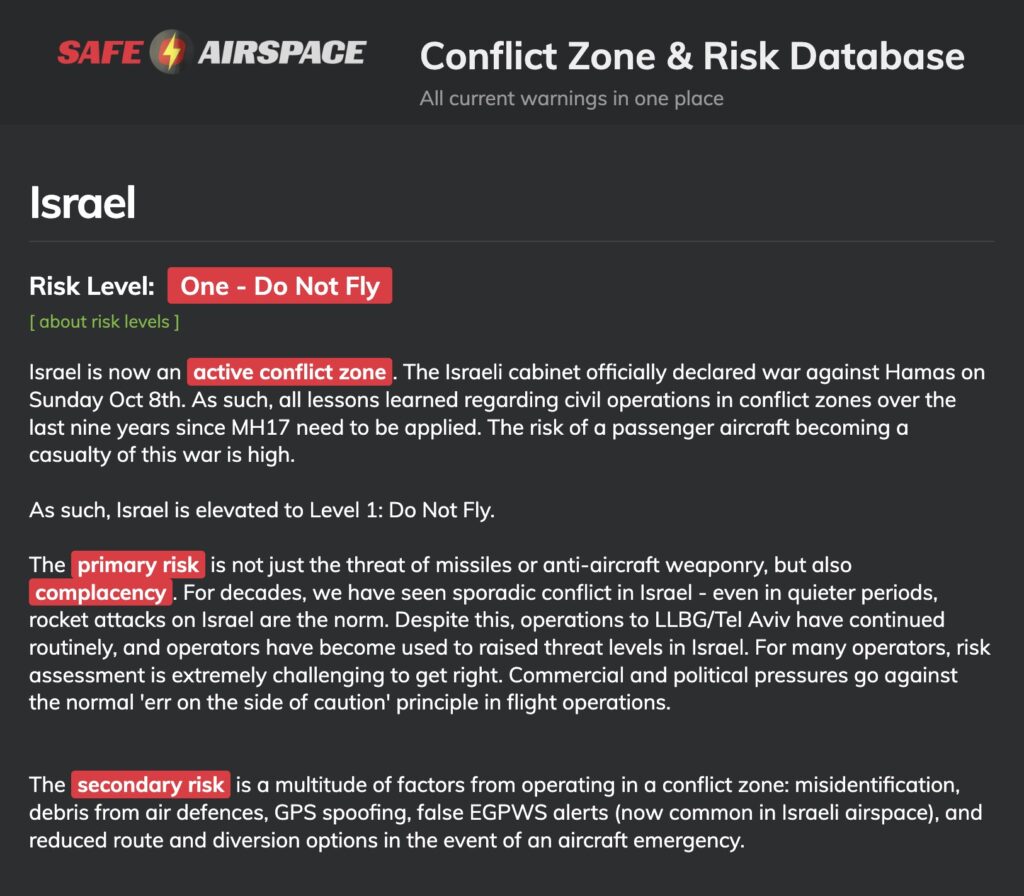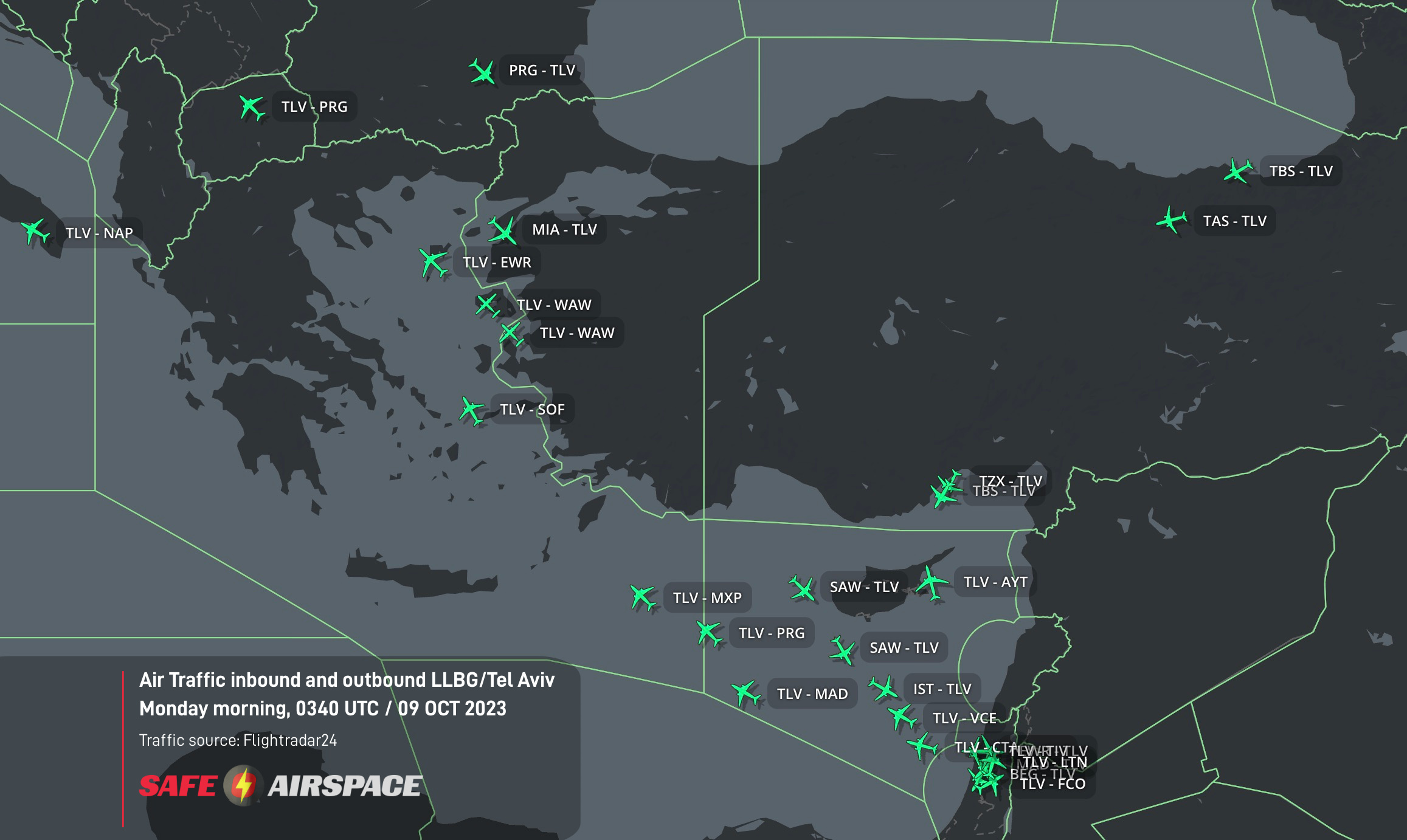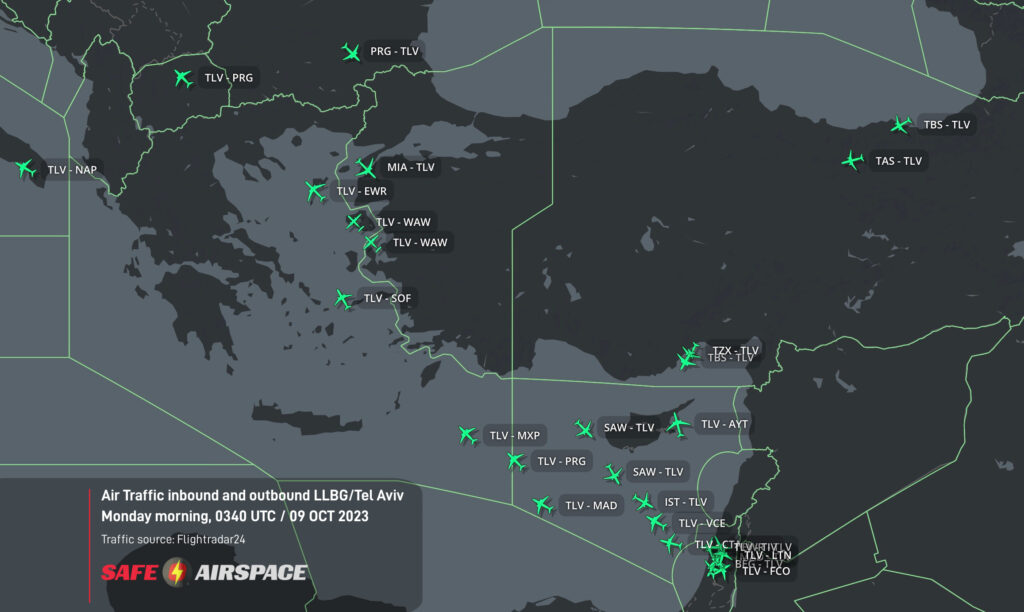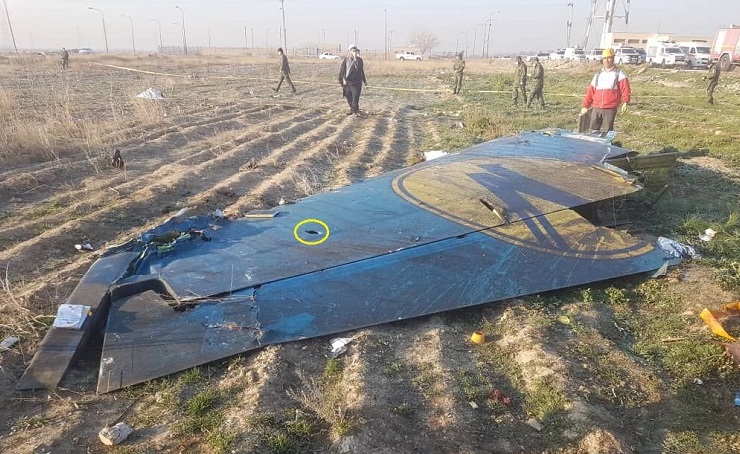Airspace Risk: Israel Level 1 – Do Not Fly
- Key message to operators and flight crew: LLBG/Tel Aviv is still busy – and it shouldn’t be.
- Safe Airspace Risk – Israel Level 1 – Do Not Fly (Full warning text)
- Civil Shootdown risk high: Lessons of MH17 and UIA752 need to be applied
Significant traffic levels still operating to Tel Aviv (Monday morning, 0340z)
Israel is now an active war zone, and therefore the Safe Airspace warning is at Level 1 – Do Not Fly. The Israeli cabinet officially declared war against Hamas on Sunday Oct 8th. As such, all lessons learned regarding civil operations in conflict zones over the last nine years since MH17 need to be applied. The risk of a passenger aircraft becoming a casualty of this war is high.
In the nine years since MH17 was shot down, we have made many advances in recognizing Conflict Zone risk to civil aviation. It’s time to apply that understanding, and avoid another civil aircraft catastrophe.
In January 2020, OPSGROUP became concerned at the heightened risk in the Baghdad and Tehran FIR. Despite issuing an alert the previous day, we were unable to prevent the shootdown of Ukraine International UIA752 on January 8th, 2020. This morning, looking at the traffic levels in the Tel Aviv FIR, we feel the same sense of unease and concern.
It should be noted that about 30% of the traffic shown in the radar image is operated by El Al, who are running normal service in order to repatriate reservists called up for duty, and citizens wishing to leave Israel. This may give operators even a sense that ops are normal – but bear in mind that these El Al flights are to some degree troop transport movements, and in fact may increase the appetite for making civil aircraft a target.
The ultimate sentiment from MH17 still echoes: “What were they doing flying over a war zone“? We truly hope the same question doesn’t need to be asked in Tel Aviv airspace this week.
OPSGROUP recommends full avoidance of Israeli airspace
- Avoid all Israeli destinations (LL**), especially LLBG/Tel Aviv
- Avoid overflight of Tel Aviv FIR (LLLL)
- Carefully consider route choices into OJAI/Amman, Jordan and other OJ** airports

A detailed briefing is published at: https://safeairspace.net/israel
Primary Risk : Complacency
The primary risk is not just the threat of missiles (hundreds are being directed at LLBG as this is being written) or anti-aircraft weaponry, but also complacency (or a false sense of security). For decades, we have seen sporadic conflict in Israel – even in quieter periods, rocket attacks on Israel are the norm. As such, operations to LLBG/Tel Aviv continued, and operators have become used to raised threat levels in Israel.
This situation is absolutely not routine.
Further risk comes from a multitude of factors from operating in a conflict zone: misidentification, debris from air defences, GPS spoofing, false EGPWS alerts (now common in Israeli airspace), and reduced route and diversion options in the event of an aircraft emergency.
Risk Assessment, no authority guidance
Despite the elevated risk, no prohibitions or restrictions have been issued by any national aviation authority, the FAA, or EASA. One exception: the Russian FATA has restricted their operators to daylight ops only.
Israeli CAA warning: A golden rule in Conflict Zone understanding has been written on the Safe Airspace portal since it first launched in 2015: “Operators should note that in general, the Civil Aviation Authorities of the countries whose airspace is determined to be unsafe are (very) unlikely to issue reliable guidance.” The Israeli CAA issued NOTAM A1092/23 on Sunday, which draws attention to the security risk, but does not provide any guidance, closures, or restrictions. In fact, the omission of any restrictions present the connotation that routine operations can be expected other than “delays and fuel” issues. This is misleading.
An FAA FDC NOTAM (FDC 3/2050) advises operators to exercise extreme caution when operating within the Tel Aviv FIR. An EASA “Conflict Zone Information Bulletin” simply says to check the Israeli NOTAM, and that “The fact that Israel has issued and is maintaining NOTAMs regarding its airspace and its main airports demonstrates that the Civil Aviation Authority of the state of Israel is actively managing the risk to civil aviation. At present, there are no indications that these mitigation measures are not efficient or inadequate.” This is also misleading – the risk to civil aviation is not being managed.
The standard line now is “carry out a risk assessment“. For many operators, risk assessment is extremely challenging to get right. Commercial and political pressures go against the normal ‘err on the side of caution‘ principle in flight operations. Larger operators may have the ability to complete dedicated risk assessments, but the majority of flight crew and operators need better guidance from aviation authorities.
Consider that in the 2014 Hamas rocket attacks – a far less intense event – the FAA responded with a 2 day prohibition for LLBG and EASA advised operators to suspend flights. The current situation in Israel is only going to escalate in the coming days, as the country begins their return offensive against Palestine.
It would be helpful to many flight crew and operators if the same duty of care was extended to them again in this situation.
Resources:
- Safe Airspace: Israel – Level 1: Do Not Fly
- Israel information page: current NOTAMs, prohibitions, restrictions
- OPSGROUP Crewroom (Members): Latest Alerts, Discussion
- Contact team@ops.group for any questions
More on the topic:
- More: Israel Tightens Rules For GA Flights From The US
- More: April 2024: Israel/Iran Situation, All Call active
- More: May 2021: Israel Airspace Risk
- More: Feb 2018: Tel Aviv Airport closes as a precaution against attack
- More: Strike cancelled at Tel Aviv Airport
More reading:
- Latest: Teterboro: RIP the RUUDY SIX
- Latest: 400% increase in GPS Spoofing; Workgroup established
- Latest: GPS Spoofing WorkGroup 2024
- Safe Airspace: Risk Database
- Weekly Ops Bulletin: Subscribe
- Membership plans: Why join OPSGROUP?













 Get the famous weekly
Get the famous weekly 






There is also this NOTAM prohibiting the operation of GA AIRCRAFT
LLBG A1089/23 08OCT1328-19OCT1600 ARR OF GA ACFT PROHIBITED FM OCT 08 0500UTC (0800LMT). DEP OF GA ACFT PROHIBITED FM OCT 08 1700UTC (2000LMT).